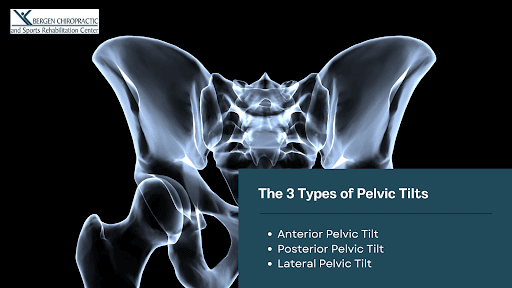If you’re dealing with a funky pelvic tilt and feeling like you’re out of alignment, check in with a pelvic tilt chiropractor. These skilled professionals can help get your hips back in the groove.
How, exactly?
Let’s explore the world of chiropractic care for pelvic tilt, as well as other DIY physical therapy approaches to bring everything back in alignment!
What is a Pelvic Tilt?
You know that bony structure sitting at the base of your spine, the one you’re probably sitting on right now? That’s your pelvis.
The term “pelvic tilt” refers to the orientation or alignment of the pelvic region in relation to the thigh bones.
Imagine your pelvis is a bowl of soup. In a perfect world, that bowl is nice and level, right? But sometimes, the front of your “bowl” dips forward, backward, or to one side, causing the 3 types of pelvic tilt.
The 3 Types of Pelvic Tilts

Anterior Pelvic Tilt
When dealing with an anterior pelvic tilt, the front of your pelvis drops, and the back of it lifts up. It’s like spilling the soup out the front of your bowl.
This misalignment can lead to a pronounced curve in your lower back (imagine a duck’s posture). Common signs of anterior pelvic tilt include tight hip flexors and a slightly bulging belly.
Posterior Pelvic Tilt
When dealing with a posterior pelvic tilt, the front of your pelvis rises, and the back drops. It’s like you’re trying not to spill your soup as you lean back in your chair.
Posterior pelvic tilts can result in a flattened lower back, as well as tight hamstrings and glutes.
Lateral Pelvic Tilt
Due to a lateral pelvic tilt, one hip is higher than the other, causing your pelvis to tilt sideways. Imagine tilting your soup bowl to one side.
This tilt can result in one leg appearing shorter than the other, throwing your whole body’s alignment off.
8 Most Common Causes of Pelvic Tilt

Poor Posture
Slouching isn’t just bad for your back — it can throw your pelvis out of whack, too. Spending a long time sitting or standing with poor posture can lead to a muscle imbalance and, voila, a tilted pelvis.
Sedentary Lifestyle
If your favorite position is couch potato, then your body might not be getting the movement it needs to preserve muscle balance. Inactive muscles can get tight or weak, causing an anterior or posterior pelvic tilt.
Exercise Imbalance
On the flip side, too much of a good thing can also lead to problems. If you’re overworking certain muscles while neglecting others during your workouts, you could end up with a muscle imbalance leading to a tilted pelvis.
Pregnancy
Carrying around a growing baby for nine months can put a lot of pressure on the pelvis. The added weight and shift in the body’s center of gravity can lead to an anterior pelvic tilt.
Obesity
Carrying around extra weight, especially in the belly area, pulls the pelvis forward, leading to an anterior tilt.
Injury or Surgery
Any injury or surgery affecting your range of motion can change the alignment of your pelvis.
Leg Length Discrepancy
If one of your legs is longer than the other (and we’re talking more than a tiny difference), it can cause a lateral pelvic tilt.
Does Hip Replacement Cause Pelvic Misalignment?
Hip replacement surgery may indeed affect your pelvic alignment, at least temporarily.
During a hip replacement, the surgeon installs an artificial joint that may not exactly match the length or angle of your original hip. The new joint leads to a change in your body’s biomechanics, potentially leading to a tilted pelvis.
After a hip replacement, you’ll be taking it easy for a while, during which time certain muscles weaken from disuse, potentially causing a tilted pelvis. Furthermore, you might start favoring your non-operated leg while moving around, throwing your pelvis off-kilter.
7 Symptoms of a Tilted Pelvis

- Lower back pain: The most noticeable symptom of pelvic instability. Your lower back will feel tense or sore, especially after a long day of standing or sitting.
- Hip or knee pain: Your hips or knees will start acting up, too, because a tilted pelvis puts extra strain on these areas.
- A noticeable difference in leg length: When your pelvis tilts, it can make one leg seem shorter than the other.
- Stiffness or restricted movement: You might find it hard, awkward, or uncomfortable to move around as freely as before.
- Changes in your posture: Anything from a protruding belly (even if you’re otherwise slim) to an overly curved or flat lower back.
- Difficulty with certain activities: Things like running, squatting, or climbing stairs might become more challenging.
- Weak or tight muscles: Depending on the type of tilt, some of your muscles (for example, your hip flexors or lower back muscles) may feel unusually tight, while others (your abdominal muscles or glutes) may seem weak or hard to engage.
How Do Chiropractors Correct a Pelvic Tilt?
Chiropractors are experts at manipulating the body to improve alignment, reduce pain, and increase function — all issues related to pelvic tilts.
First, your chiropractor will start with a thorough evaluation. They’ll check your posture and gait to figure out your sort of pelvic tilt, as well as what’s causing it.
Next, they’ll use an array of techniques to help correct the tilt:
- One of the main chiropractic techniques is spinal adjustments or manipulations. These are quick, controlled movements aimed at realigning your spine and pelvis.
- Chiropractors also recommend treatments such as massage, heat or cold therapy, and electrical stimulation.
- Your chiropractor will also teach you DIY exercises and stretches to strengthen weak muscles and stretch tight ones — the key for maintaining proper alignment.
3 Exercises to Correct Anterior Pelvic Tilt
Exercise is an awesome way to strengthen and stretch the muscles behind an anterior pelvic tilt:
1. Bridges: Lie flat on your back, bend your knees, and keep your feet flat on the floor. Then, lift your hips off the floor while keeping your back straight. Hold for a few seconds, then lower back down. Start with a few reps, and work your way up.
Postpartum exercise: Pelvic tilt with bridge
2. Planks: Everyone’s favorite! They’re tough, but excellent for core strength. Make sure you’re keeping your body straight like a plank of wood. No sagging or lifting your butt too high.
3. Hip flexor stretches: Your hip flexors are often tight if you have an anterior pelvic tilt. To stretch them, kneel on one knee, and push your hips forward. You should feel a stretch in the front of your hip. Hold for 20-30 seconds, then switch sides.
2 Exercises to Address Posterior Pelvic Tilt
If you’ve got a posterior pelvic tilt, you need to strengthen your abs and stretch your hamstrings:
1. Leg raises: Lie flat on your back, then slowly lift one leg at a time. Keep your legs straight and your toes pointed.
2. Hamstring stretches: You can do these stretches while standing or sitting. Just reach for your toes and keep your legs straight. You’ll feel a nice stretch in the back of your legs.
How to do a seated hamstring stretch
Dr. Doerr’s Chiropractic Adjustments Will Help Correct Your Pelvic Tilt!
At Bergen Chiropractic and Sports Rehabilitation Center, our chiropractic team, under the leadership of Dr. Gregory Doerr, adheres to the highest and most professional medical standards to provide superior chiropractic help. Our mission is to provide unparalleled patient care in a comfortable, healing atmosphere.
Access our contact form or call us at (201) 945-4075 to learn more about our chiropractic care services! Our offices at 532 Anderson Avenue, Cliffside Park, NJ 07010, and 62 Summit Ave, Hackensack, NJ 07601, are ready to welcome you as we proudly serve the areas of New York, New Jersey, Philadelphia, PA, and Baltimore, MD. Also, feel free to access our blog, Facebook, and Instagram pages for more information on chiropractic adjustments!








